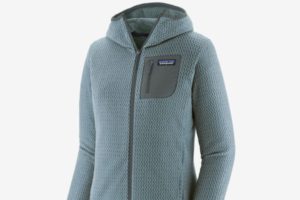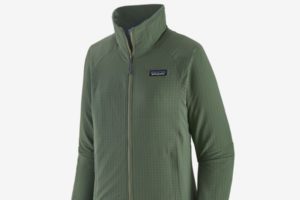Patagonia has been providing high-quality outdoor apparel and gear for years, and two of their fleece jackets, R1 and R1 Air, caught the attention of many outdoorsy folks.

They’re both designed for performance and comfort in cool to cold weather conditions, but they differ in some key aspects.
If you’re interested in buying one of these two but don’t know which one, you’re in luck. In this article, I’ll compare the Patagonia R1 vs. R1 Air in detail.
More specifically, I’ll explore their similarities and differences so that you can determine which might best fit your outdoor activities. So, let’s just dive right in.
What’s the Difference Between Patagonia R1 and R1 Air?
When looking closely at Patagonia R1 and R1 Air, you can notice some differences that can impact your final choice. Let’s look closely at each of these differences.
Patagonia R1 vs. R1 Air: Warmth
One of the differences between the Patagonia R1 and R1 Air is the level of warmth they provide.
For instance, R1 is a classic mid-layer that offers warmth and versatility.
It’s made from Polartec Power Grid fabric, so it’s breathable, quick-drying, and has a high warmth-to-weight ratio.
On the other hand, R1 Air is a newer addition to the R1 family. And it’s more breathable and lightweight because it’s made from a stretchy, lightweight polyester knit.
In other words, R1 Air provides some warmth. However, it’s better suited for high-output activities where you might overheat in a heavier layer.
Patagonia R1 vs. R1 Air: Weight
Regarding weight, the Patagonia R1 and R1 Air have distinct differences.
The R1 Air is significantly lighter than the R1. So, it’s a great choice for those prioritizing weight and breathability over warmth.
The R1 Air has a unique knit construction that increases airflow and breathability while providing some insulation.
This lightweight design makes it a great choice for high-output activities like running, climbing, or hiking, where you need to stay cool and comfortable.
The R1 Air usually weighs less than R1 because it’s made of a lighter mid-layer.
On the other hand, the R1 is a bit heavier than the R1 Air, partly because of the denser fabric, which provides more warmth and protection from the elements.
However, the final weight depends on the specific model.
Overall, if you need a lightweight and breathable layer for high-output activities, the R1 Air is a great option.
However, the R1 can keep you comfortable in various conditions if you’re looking for warmth and versatility.
Patagonia R1 vs. R1 Air: Weather-Resistance
Neither the R1 nor the R1 Air is weather-resistant. However, they can be layered under a shell to provide some protection from wind and light precipitation.
If you’re looking for a mid-layer that provides more weather resistance, you might want to consider the Patagonia Nano-Air or Nano-Puff instead.
Patagonia R1 vs. R1 Air: Athletic Fit
R1 and R1 Air have a great athletic fit, meaning they’re meant to be worn close to the body.
This can help maximize their warmth and breathability but also make both models less comfortable for some people.
If you prefer a looser fit, you might want to consider sizing up.

Patagonia R1 vs. R1 Air: Comfort
The R1’s Polartec Power Grid fabric is known for being soft, stretchy, and comfortable against the skin.
The R1 Air’s lightweight knit fabric is also soft, comfortable, and has a bit more stretch than the R1.
Moreover, both layers have minimal seams to reduce irritation and chafing.
Patagonia R1 vs. R1 Air: Materials
The R1 is made from Polartec Power Grid, a proprietary fabric that’s breathable, quick-drying, and warm.
On the other hand, R1 Air consists of a stretchy, lightweight polyester knit. Therefore, it’s breathable and quick-drying.
Moreover, they’re both blue sign approved, which means they meet strict environmental and social standards.
Patagonia R1 vs. R1 Air: Styles
The R1 and R1 Air come in various styles, including hooded and non-hooded versions.
The R1 is also available in a full-zip style, which makes it easier to put on and take off, while the R1 Air is only available in a half-zip style.
The hooded versions of both models make a great choice for adding more warmth and protection on colder days, while the non-hooded versions work better for layering under a shell or wearing on their own during high-output activities.
They also come in different colors and sizes.
Patagonia R1 vs. R1 Air: Number of Pockets
The R1 has one chest pocket with a zipper closure.
On the other hand, R1 Air has two handwarmer pockets on the front and a zippered chest pocket. So, the R1 Air has one more pocket than the R1.
The technical design of the R1 Air calls for extra pockets, as it’s intended for high-output activities.
The handwarmer pockets provide additional storage for small items, while the chest pocket can store items that must be kept secure.
Patagonia R1 vs. R1 Air: Washing and Drying
I own Patagonia R1 and R1 Air, so I know something about washing and drying these garments properly.
As mentioned, R1 is a classic fleece jacket made of Polartec Power Grid fabric. On the other hand, R1 Air is made of Capilene Air fabric, so it’s more lightweight.
Since they’re made of different materials, they require different washing techniques.
For starters, you can wash the R1 in the washing machine with cold water and mild detergent. However, you should avoid bleach, fabric softeners, or other chemicals.
Otherwise, you might damage the fabric.

Extra tip: I usually turn my R1 inside out before washing it in the machine to prevent pilling and ensure it’s 100% clean.
I also wash my R1 separately from other clothes to prevent potential color bleeding.
When washing my R1 Air, it’s a bit more complicated because it’s made of a more delicate fabric that can easily snag or pill if washed incorrectly.
I suggest washing your R1 Air in cold water with mild detergent.
Also, avoid wringing it out. If you must wash your R1 Air in the washing machine, use a delicate cycle with cold water.
Lastly, avoid using bleach, fabric softeners, or other chemicals.
As for drying, I recommend air drying both R1 and R1 Air. However, avoid hanging them in direct sunlight or near a heat source. Otherwise, you might damage the fabric.
Overall, R1 and R1 Air aren’t high-maintenance.
They’re easy to wash and dry, but R1 Air needs extra TLC because it’s made of delicate fabric.
Still, with proper care and attention, both will stay in excellent condition for many years.
Patagonia R1 vs. R1 Air: Price
Regarding price, the R1 Air is slightly more expensive than the R1. This is likely due to the newer, more lightweight fabric used in the R1 Air.
Conclusion
Well, there you have it! What’s your pick? Patagonia R1 and R1 Air make great fleece jackets for outdoor enthusiasts who want comfort and durability.
While they’re similar in their stretchiness and breathability, these models differ in weight and insulation.
However, whether you choose the R1 or R1 Air, you can rest assured that you’re buying high-quality outdoor apparel that will keep you comfortable and performing at your best for years.

I was working as a mountain guide, probably all around the planet. One day, I met my wife in the mountains, literally on top of the world. Now, I have a beautiful family and three kids, so I don’t have much time for climbing, but sometimes I go camping with my friends. I am also into gym workouts, and I can’t imagine my life without sports.
Since I ended my professional career as a climbing guide, I’ve been giving personal classes and helping amateurs to get ready for conquering their first peaks. Also, that’s how the whole blog idea appeared.





